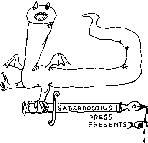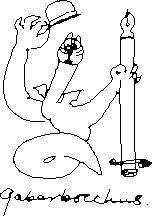
Artwork: Franciszka Themerson


Artwork: Franciszka Themerson
The Themersons and the Gaberbocchus Press Ñ an Experiment in Publishing 1948-1979 is a recent collection of essays edited by Jan Kubasiewicz and Monica Strauss, published by MJS Books and Graphics, New York. Designed in the visually rich tradition of the Gaberbocchus Press, this publication is at once a catalogue accompanying its first exhibition in the United States, a design resource, and an eloquent enticement for further exploration of the Themersons' work.
Gaberbocchus is a Latin term for a dragon, and also appears as a hero in the fables of Alice in Wonderland. As a symbol of the press, it stretches the imagination across the vast context of disciplines and influences that informed the Themersons in their publishing work. Lewis Carroll, less known as the mathematician Charles Dodgson, fostered a fascination with language, logic, and philosophy which the Themersons avidly shared.
Jan Kubasiewicz, Professor of Design and Design History at the University of Hartford and a dedicated admirer of the Themersons' work, co-edited the content while forming the overall graphic presentation of this publication. Unintimidating and well-suited for comfortable reading, its dimensions are those of the ubiquitous page, 8 1/2" x 11". The light bristol cover is printed in gray, evenly-textured linen. Upon it appear four cut-out shapes which playfully summarize the content. Each stems from a different work and different medium within the Themersons' oeuvre: illustration, painting, writing and experimental film. Embedded in these segments are two negative silhouettes of the capital letter T and two connecting symbols. Inside, wide, airy columns with double spaced lines of sans serif type are a consistent thread of clarity amid an abundance of line drawings, photographs and photograms, negative images, and various reproductions.
The basis of the Gaberbocchus press is the unique partnership between Franciszka and Stefan Themerson. They managed to work as a team in a way that allowed each to retain their identity. Their work does not overlap in the sense that the images illustrate the text or the text describes the images rather, the content of the work emerges out of a dynamic tension between the visual and verbal elements, complementing and extending each others' potency.

Artwork: Franciszka Themerson
The Themersons prided themselves on defying categorization and conformity. Among their preferred devices was combining incongruous elements in surprising arrangements, while breaking the rules of logic and conventional use of language. Their collaboration started with their shared interest in film. Together they produced seven experimental films Ñ five in Poland during the 1930s and two during the Second World War in England. This early work is rooted in their interest in translating language into still, visual images, charged with emotional and intellectual content. The film "Europa," for instance, was directly inspired by Anatol Stern's poem of the same title. They matched the written language with sequences of still photographs and photograms that activated each others' potential meaning, as would words in a poem. The range of the Themersons' collaboration also included publication of children's books, of which they made more than a dozen during the 1930s. These books as well as those of the future Gaberbocchus press were mostly written by Stefan and illustrated by Franciszka.
In 1937, the Themersons decided to move to Paris; their stay however, turned out to be shorter than planned and the war brought them to England where in 1948 they established the Gaberbocchus Press. In the following 31 years of its existence, the press published over sixty titles, including works by Alfred Jarry, Guillaume Apollinaire, Heinrich Heine, Kurt Schwitters, Bertrand Russell, and many more. Jarry's Ubu Roi became one of their most celebrated books, published in many editions.
The Themersons consistently experimented with the cross-influence between meaning and form. "Internal Vertical Justification" is a device developed by Stefan to expand on the possible meaning of a word. A dictionary definition was printed in a list-form underneath the word in a sobering juxtaposition to its original poetic connotations. This way of writing led to what Stefan called "Semantic Poetry" - an attempt to strip words of accumulated stereotypes and clichŽs, resembling the post- structuralist approach to language. Preoccupation with language and means of communication became the essence of their philosophical conviction. As Jan Kubasiewicz aptly puts it in his extensive essay, to them the tragic factor in human existence reveals itself through the aggressive and destructive potency of ideas. Thus, the Themersons emphatically abandoned claims to any "message"; rather, they stated "Decency of Means" in itself as the essential impulse of their work. In 1979, the press was turned over to their friend, the Dutch publisher Jaco Groot, and nine years later both Themersons died.
In their life, as in their work, they defied borders and constantly eluded categorization. This peculiar "in between" existence influenced their work; they simultaneously participated in the cultural life of Poland, France, Holland, and England without exclusive identification with any one of them. Likewise, those cultures did not hasten to include them fully in their artistic establishments. This circumstance, however, strengthened their position as a significant alternative voice.
Highlights of Themersons' life and work recur occasionally in the four main essays of this publication, each with a focus on a different aspect of their career. Marcin Gizycki gives a thorough overview of the couple's experimental filmwork, stating that the Themersons were the most significant Polish independent experimental filmmakers of the interwar years. He discusses their technique, tracing their fascination with abstraction of language and image when separated from narrative content. Unfortunately, most of the Themersons' filmwork was lost during the war and only isolated still frames survived. These include close-ups of various objects, collaged urban-scapes, shadowy architectural interiors, images from nature and art. Some appear clearly, others dissolve in pools of light. These images are dispersed throughout the article, some aligned vertically, some aligned on consecutive pages, mimicking their existence in a film sequence.
Nicholas Wadley, an art historian and an intimate friend of the Themersons, describes the luscious and seductive experience of handling a Gaberbocchus book. He reports how these books took hold of his imagination. He found them affectionate, ridiculous, merciless, and moral all at once. The Themersons, he writes, managed to strike a poetic dialogue between the extraordinary and the commonplace. The question Wadley poses is the one Stefan Themerson posed to his audience; namely: could the Gaberbocchus books maintain actuality?

Artwork: Franciszka Themerson
Sofia Zezmer
Sofia Zezmer is an artist who lives and works in New York and Wiesbaden, Germany. She earned her degrees from Cooper Union (B.A. in Fine Art Studies, Sculpture), and from Hunter College (M.A. in Art History, Constructivism).

URL: http://www.engin.umich.edu:80/~zbigniew/Periphery/themersons.html